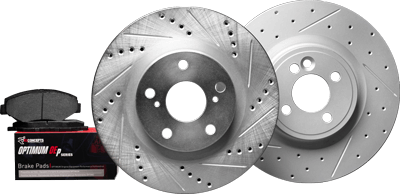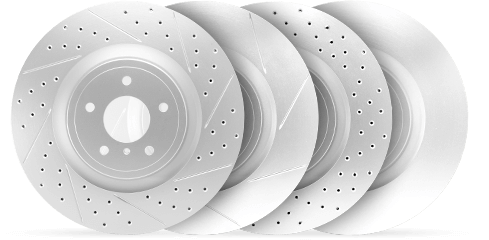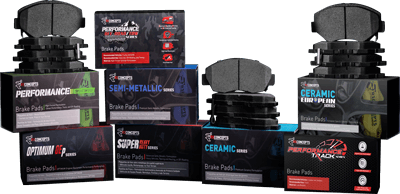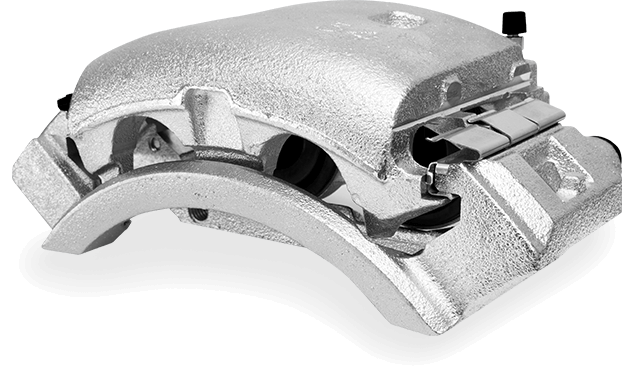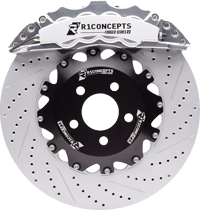Discover the best brake pad types for Toyota Camry. We compare ceramic, semi-metallic, and organic pads to help you choose the best fit for your driving style.
Key Takeaways
Toyota Camry brake pads come in three types: ceramic, semi-metallic, and organic, each suited for different driving conditions and needs.
Ceramic brake pads are quiet and produce less dust but are more expensive and less effective in extremely cold conditions; semi-metallic pads offer strong braking and heat resistance but create more noise and dust; organic pads are quieter and affordable but wear out quicker.
Choosing the right brake pads involves considering driving habits, environmental conditions, and budget, with proper installation and maintenance being crucial for optimal performance and longevity.
Types of Brake Pads for Toyota Camry
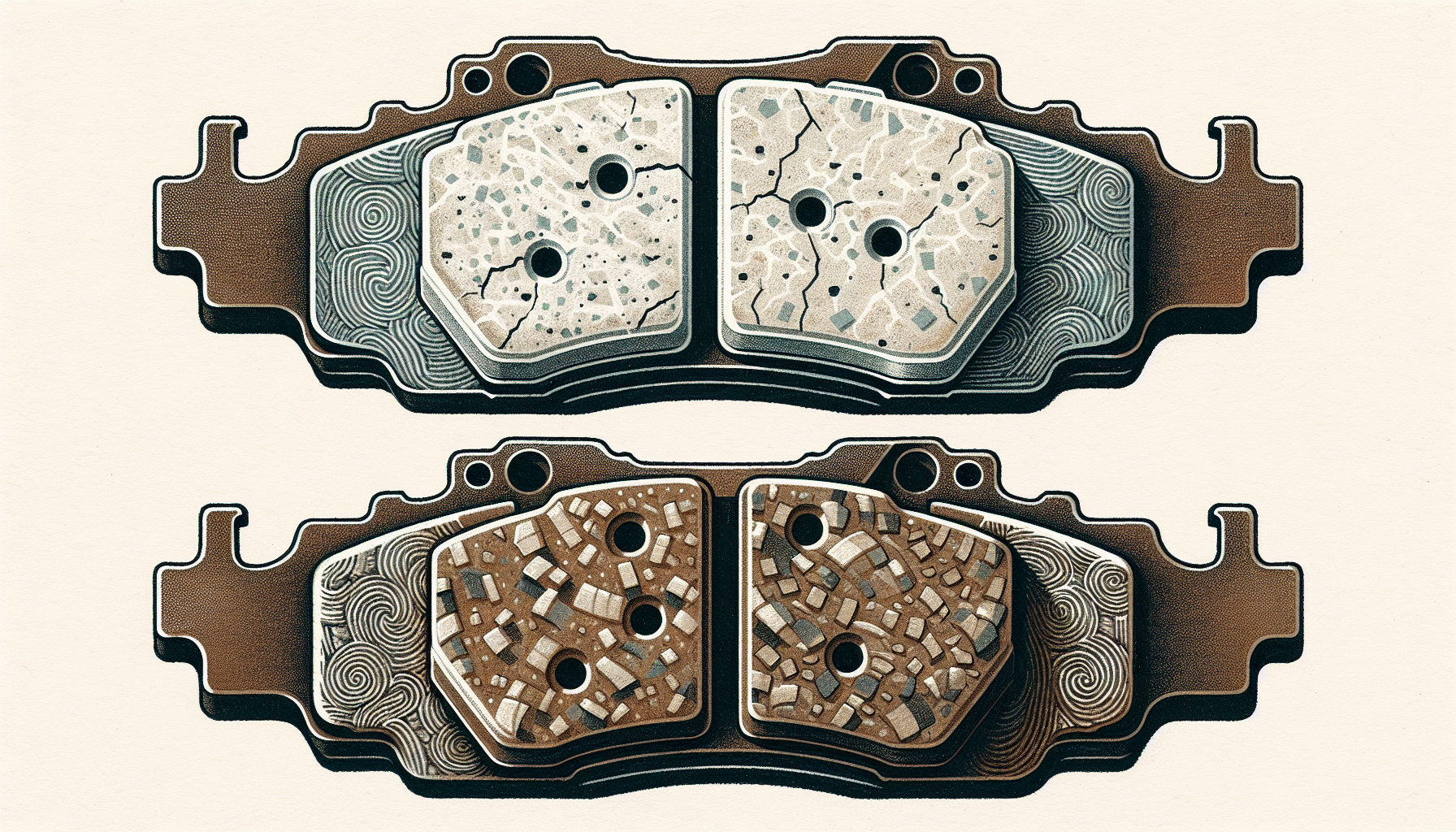
Toyota Camry brake pads typically come in three main varieties: ceramic, semi-metallic, and organic. Each type offers distinct advantages and disadvantages, making it crucial to understand which suits your driving style and conditions best.
Ceramic brake pads are known for their quiet performance and minimal dust production. Semi-metallic brake pads, on the other hand, provide strong braking performance and heat resistance, making them ideal for more aggressive driving. Organic brake pads offer a quieter, more affordable option, although they tend to wear out quicker.
We’ll explore each type in greater detail to assist you in making an informed decision.
Ceramic Brake Pads
Ceramic brake pads are a fantastic choice for those who prioritize a quiet and clean driving experience. These brake pads are designed to emit noise above the normal human hearing range, ensuring quieter braking. Additionally, they produce lighter, less sticky brake dust compared to other types, which means your wheels will stay cleaner for longer.
One of the standout benefits of ceramic brake pads is their durability. They can handle high temperatures without breaking down, and their efficient heat dissipation reduces the likelihood of fading or warping. This makes them a reliable choice for various weather conditions, including wet environments.
Keep in mind, however, that ceramic brake pads tend to be more expensive. They are more expensive but offer stability across a wide range of temperatures. The primary drawback is their lesser bite compared to semi-metallic pads, making them less suitable for extremely cold climates.
Semi-Metallic Brake Pads
Semi-metallic brake pads are the go-to choice for performance-driven drivers. Composed of a blend of metals such as steel, copper, and iron, these brake pads offer superior braking performance and heat resistance. They are especially favored by those with aggressive driving habits due to their ability to handle a wide range of temperatures and demanding driving conditions.
These brake pads are ideal for those who need strong initial bite and fade resistance, making them suitable for high-speed highway driving. However, the trade-off comes in the form of increased noise and dust production. Semi-metallic pads tend to be noisier and produce more brake dust, which might require more frequent cleaning of your wheels.
Despite these drawbacks, the enhanced performance and durability of semi-metallic brake pads make them a solid choice for drivers who prioritize stopping power and heat resistance.
Organic (Non-Asbestos) Brake Pads
Organic brake pads, also known as non-asbestos organic (NAO) pads, are crafted from a mixture of fibers and materials like rubber, carbon compounds, and Kevlar. These brake pads are generally more affordable and produce moderate friction, making them a popular choice for city drivers who frequently stop and go.
One of the key benefits of organic brake pads is their quiet operation. They generate less noise than semi-metallic pads, providing a smoother and quieter driving experience. Additionally, they produce less dust, which can help keep your wheels cleaner. However, this softness also means that organic brake pads tend to wear out quicker than ceramic or semi-metallic options.
For those who drive mainly in the city and are looking for an affordable, quiet option, organic brake pads are a great choice. Just be prepared for more frequent replacements compared to other types.
Choosing the Right Brake Pads for Your Toyota Camry
Choosing the appropriate Toyota Camry brake pads requires more than simply selecting a type. It’s necessary to take into account factors like OEM recommendations, driving environments, and your budget to guarantee peak performance and safety.
Your driving conditions and habits significantly influence the type of brake pads you need. The requirements for city drivers, highway commuters, and aggressive drivers all vary, and we’ll delve into these differences. Additionally, budget considerations are crucial, as the initial cost of brake pads can impact long-term maintenance expenses.
Lastly, to ensure your brake pads operate optimally, proper installation and maintenance are paramount. Adhering to the correct procedures can ward off issues such as squeaking and excessive rotor wear.
Driving Conditions and Habits
The choice of brake pads is significantly influenced by your driving environment and style. For instance, city drivers who frequently stop and go require brake pads with better heat dissipation. Organic brake pads are often a good fit for this scenario due to their quiet operation and moderate friction.
On the other hand, high-speed highway drivers need brake pads that offer strong initial bite and fade resistance. Semi-metallic brake pads are ideal for this type of driving, thanks to their superior performance and heat resistance. Meanwhile, aggressive drivers should consider high-quality brake pads capable of handling more demanding driving conditions.
For those driving in harsh climates, it’s essential to choose brake pads that are durable and resistant to salt and water. Additionally, brake pads are not recommended for heavy-duty applications like hauling, as they require greater pressure to achieve the same stopping power.
Budget Considerations
Although low-cost brake pads might seem like a bargain at first, their faster wear often leads to more frequent replacements. This can result in higher long-term costs despite their lower initial price.
Investing in higher-quality brake pads can provide the following benefits:
Reduced long-term maintenance costs due to increased durability
Improved performance and braking efficiency
Longer lifespan, resulting in less frequent replacement
Enhanced safety and reliability on the road
Although the upfront cost may be higher, the improved performance and longevity of premium brake pads often make them a more economical choice in the long run.
Installation and Maintenance Tips
To guarantee optimal performance, correct installation and maintenance of brake pads are indispensable. Before starting the installation, ensure you have a well-lit and clean workspace. Always use a jack and jack stands to safely lift and support your vehicle during the replacement process.
The installation process involves accessing the brake caliper, retracting the pistons, and correctly fitting the new pads. Using appropriate tools and applying braking lubricant can prevent squeaking and ensure optimal performance. Ceramic pads, in particular, can cause excessive rotor wear if not paired with high-quality rotors.
Following these tips can help you maintain your brake pads and avoid common issues, ensuring a smooth and safe driving experience.
Summary
In conclusion, choosing the right brake pads for your Toyota Camry involves understanding the unique benefits and drawbacks of ceramic, semi-metallic, and organic brake pads. Each type offers different advantages, from the quiet and clean performance of ceramic pads to the strong braking power of semi-metallic options and the affordability of organic pads.
It’s essential to consider your driving conditions and habits, as well as your budget, when making a decision. Investing in higher-quality brake pads can lead to long-term savings and improved performance. Additionally, proper installation and maintenance are key to ensuring your brake pads perform at their best.
By taking the time to understand your options and make an informed decision, you can ensure your Toyota Camry remains safe and reliable on the road. Happy driving!
Frequently Asked Questions
What are the main types of brake pads for Toyota Camry?
The main types of brake pads for a Toyota Camry are ceramic, semi-metallic, and organic (non-asbestos). Choose the one that best suits your driving needs.
Are ceramic brake pads worth the higher cost?
Yes, ceramic brake pads are worth the higher cost because they offer quiet performance, minimal dust production, and durability.
Which brake pads are best for aggressive driving?
Semi-metallic brake pads are the best choice for aggressive driving due to their strong braking performance and heat resistance.
How often should I replace my organic brake pads?
You should replace your organic brake pads more frequently than other types, depending on your driving habits.


